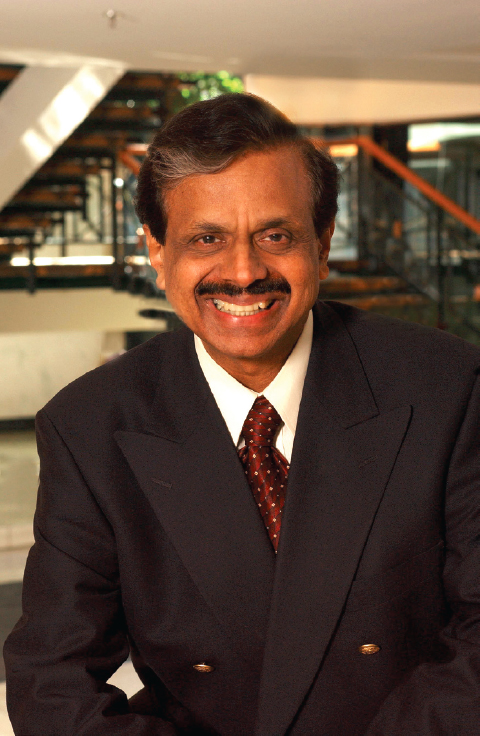PRABHA S. KUNDUR
1939–2018
Elected in 2011
“For contributions to modeling and control techniques to enhance the stability and reliability of large electric power systems.”
BY VIJAY VITTAL
PRABHA SHANKAR KUNDUR, an outstanding electrical engineer, visionary leader in the development of analytical tools, and industry consultant, passed away at the age of 79 on October 9, 2018. He made significant contributions to the understanding of the dynamic behavior of large power grids, enabling better analysis and control to avoid large-scale blackouts and enhance power system stability and reliability.
Prabha was born in Bengaluru, India, on March 18, 1939. He obtained his BE degree from Mysore University in 1959, his ME degree from the Indian Institute of Science, Bengaluru, in 1961, and his MASc and PhD degrees from the University of Toronto in 1965 and 1967, all in electrical engineering. Upon completion of his doctoral studies, he returned to India to teach at Bengaluru University before accepting a position as analytical engineer at Ontario Hydro, Canada, in 1969.
During his nearly 25 years at Ontario Hydro, he held senior-level positions, as head of the Systems Controls & Transient Section and manager of the Analytical Methods & Specialized Studies Department in the Power System Planning Division. In 1993 he joined Powertech Labs Inc., the research and technology subsidiary of BC Hydro, where he served as president and CEO from 1994 to 2006, when he retired; he was responsible for leading the development, application, and
commercialization of a variety of new technologies for the energy sector. In September 2006 he founded and was president of Kundur Power System Solutions Inc., in Toronto.
With a passion for mentoring and guiding engineers, Dr. Kundur served concurrently as adjunct professor at the University of Toronto (1979–2017), Western University (1991–99), University of British Columbia (1994–2006), and University of Manitoba (2006–17). And he wrote Power System Stability and Control (McGraw-Hill, 1994), a classic reference for those in both academia and industry. In addition, he provided extensive international consulting on power system planning and design as well as advanced technical courses for utilities, manufacturers, and universities around the world.
In the technical community, he was an active participant in the Power and Energy Society (PES) of the Institute of Electrical and Electronics Engineers (IEEE) and in CIGRE (International Council on Large Electric Systems). He was responsible for the development of several standards and a key document, jointly published by PES and CIGRE, that presented a classification and definition for power system stability. 1
Dr. Kundur pioneered important developments that advanced stability analysis of the electric power transmission grid, beginning with his original doctoral work. His contributions include digital simulation and analysis of power system dynamic performance, application of power system stabilizers, development of tools for dynamic reduction of large power systems for dynamic studies, and spearheading the development of a suite of commercial software tools that comprehensively examined three critical aspects of power system stability behavior—small-signal, transient, and voltage stability. His work directly enhanced the reliability of the electricity supply.
He was well recognized for his contributions. He was an IEEE life fellow and winner of the IEEE’s 1997 Nikola Tesla
___________________
1 Kunder P, Paserba J, Ajjarapu V, Andersson G, Bose A, Canizares C, Hatziargyriou N, Hill D, Stankovic A, Taylor C, Van Cutsem T, Vittal V. 2004. Definition and classification of power system stability: IEEE/CIGRE Joint Task Force on Stability Terms and Definitions. IEEE Transactions on Power Systems 19(3):1387–401.
award, 2005 PES Charles Concordia Power System Engineering Award, and, in 2010, Medal in Power Engineering, “For leadership in the development and application of analytical methods, tools and techniques for modeling, simulation and control of large-scale interconnected power systems.” He also received CIGRE’s 1999 Technical Committee Award and 2014 CIGRE Medal. In 2003 he was elected a fellow of the Canadian Academy of Engineering and in 2011 a foreign member of the NAE. He received honorary doctoral degrees from the University Politehnica of Bucharest (2003) and the University of Waterloo, Canada (2004). In 2012, in recognition of his technical leadership, the IEEE PES Prabha S. Kundur Power System Dynamics and Control Award was established in his honor.
To his family Prabha was a source of positivity, inspiration, and generosity. He was a loving and devoted husband to Geetha Kundur (née Halkatti) for 55 years, and great fun to his grandchildren, Linus and Ptolemy (Tolly), taking them on family vacations and bringing them gifts from around the world. He was especially proud of his daughter, Deepa Kundur, who in many ways followed in his footsteps—she is an electrical engineer and professor and chair in the Department of Electrical & Computer Engineering at the University of Toronto.





